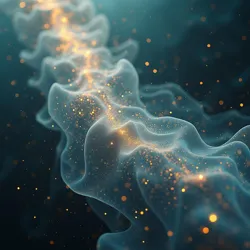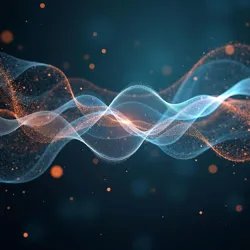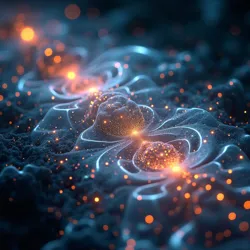Informal Flux

A dynamic ever-shifting network of potentiality and informational flow permeating all of existence, depicted in an abstract and ethereal style.
Informal Flux
['Subtle Undulation', 'Latent Permeability']
Noetics, Paleo-Semiotics
theoretical non-material medium
Cartographers of Silence
['non-locality', 'temporal permeability', 'influence on materiality']
sensory deprivation, artifacts
*Informal Flux, sometimes referred to as Subtle Undulation or Latent Permeability, is a theoretical concept within the esoteric discipline of Noetics and Paleo-Semiotics, describing a hypothesized non-material medium or substrate that permeates all of existence. It is conceived not as a tangible substance or energy field in the conventional sense, but rather as a dynamic, ever-shifting network of potentiality and informational flow. Unlike quantifiable forms of energy or matter, Informal Flux is understood to be subtle, elusive, and primarily perceptible through specialized techniques of sensory deprivation and heightened awareness, as practiced by orders such as the Cartographers of Silence*.
The concept of Informal Flux posits that reality is not solely composed of discrete objects and quantifiable forces, but also interwoven with a continuous, interconnected web of subtle influences. This flux is believed to be the medium through which information, potentiality, and even consciousness itself can propagate across space and time, transcending the limitations of conventional physical laws. While the existence of Informal Flux remains unproven by empirical methods and is largely debated within academic circles, its proponents argue that it offers a framework for understanding a range of unexplained phenomena, from apparent instances of extrasensory perception to the subtle interconnectedness observed in certain quantum experiments.
Conceptual Origins
The notion of Informal Flux has roots in various philosophical and esoteric traditions that predate modern scientific paradigms. Ancient mystical systems often described a universal substance or ether that connected all things, a concept that bears some resemblance to Informal Flux. However, the more formalized conceptualization of Informal Flux within the Khelsian context can be traced back to specific schools of thought and enigmatic figures associated with the pursuit of veiled knowledge.
 Reclusive order known for rigorous meditation mapping subtle currents of Informal Flux using specialized artifacts and sensory deprivation.
Reclusive order known for rigorous meditation mapping subtle currents of Informal Flux using specialized artifacts and sensory deprivation.Cartographers of Silence
The Order of the Cartographers of Silence is perhaps most directly associated with the articulation and exploration of Informal Flux. This reclusive order, known for their rigorous meditative practices and eschewal of conventional sensory input, developed elaborate methodologies for mapping and navigating what they perceived as the subtle currents of this flux. Their cartography was not concerned with terrestrial geography, but rather with the contours of this unseen medium, believing it to be the true map of reality.
The Cartographers posited that Informal Flux is not static or uniform, but rather exhibits dynamic patterns and undulations, akin to currents in a vast ocean. These currents, they believed, represent pathways of informational flow and potentiality, influencing everything from the seemingly random occurrences of daily life to the grand sweep of historical events. Their techniques for perceiving and mapping this flux involved prolonged periods of sensory deprivation, deep meditative states, and the use of specialized artifacts designed to amplify subtle perceptions. The maps created by the Cartographers, often intricate diagrams rendered in symbolic script, were not intended for literal navigation in the physical world, but rather as guides for traversing the landscape of potentiality and influencing the currents of Informal Flux itself.
Noetic Philosophy
The broader philosophical framework for understanding Informal Flux is provided by the discipline of Noetics. Noetics, in the Khelsian context, is concerned with the nature of consciousness, information, and their relationship to reality. Noetics departs from purely materialist viewpoints by suggesting that consciousness and information are not merely emergent properties of matter, but rather fundamental aspects of existence, perhaps even pre-existing matter itself.
Within this framework, Informal Flux is conceived as the medium through which consciousness and information are instantiated and propagated. It is seen as a kind of proto-informational field, a realm of pure potentiality from which both consciousness and material reality emerge. Noetic philosophers argue that conventional physics, focused primarily on quantifiable matter and energy, provides an incomplete picture of reality, neglecting the subtle but pervasive influence of consciousness and the informational substrate represented by Informal Flux.
The study of Informal Transmission, a phenomenon closely linked to Informal Flux, is a central focus of Noetic inquiry. Informal Transmission refers to the purported ability to communicate or transmit information through non-conventional means, bypassing the limitations of known sensory channels and physical mediums. Phenomena such as telepathy, precognition, and remote viewing are often cited as potential manifestations of Informal Transmission operating through the medium of Informal Flux.
Theoretical Framework
The theoretical underpinnings of Informal Flux draw from a range of esoteric and philosophical concepts, often incorporating analogies and metaphors to describe its elusive nature. It is frequently likened to:
- The Unseen Ocean: Informal Flux is compared to a vast, unseen ocean that underlies and permeates the visible world. Just as ocean currents shape the surface of the sea, so too do the currents of Informal Flux influence the manifest reality.
- The Fabric of Potentiality: It is described as the very fabric of potentiality, the realm of possibilities from which actuality arises. Changes in the flux are seen as shaping the probabilities of different outcomes and influencing the course of events.
- The Informational myster: In analogy to the historical concept of the luminiferous myster, Informal Flux is sometimes referred to as an informational myster, a medium that carries not light waves but rather subtle informational patterns and influences.
- The Realm of Subtle Influences: It is characterized as the domain of subtle influences, the realm where intentions, emotions, and even thoughts can have non-local effects, shaping reality in ways not accounted for by conventional physical laws.
It is crucial to note that these are primarily metaphorical descriptions, intended to provide a conceptual handle on a phenomenon that is considered inherently elusive and beyond direct sensory experience. The theoretical framework of Informal Flux is still under development and subject to ongoing refinement within the relevant esoteric and philosophical schools.
Properties of Informal Flux
While the precise nature of Informal Flux remains a subject of speculation and debate, certain properties are commonly attributed to it within the Noetic and Cartographer traditions. These properties are often described in paradoxical or counter-intuitive terms, reflecting the subtle and non-material character of the flux itself.
 Influences within Informal Flux propagating instantaneously transcending spatial distance, creating interconnectedness akin to quantum entanglement.
Influences within Informal Flux propagating instantaneously transcending spatial distance, creating interconnectedness akin to quantum entanglement.Non-Locality and Entanglement
One of the most significant properties ascribed to Informal Flux is non-locality. This refers to the idea that influences within the flux can propagate instantaneously, or at least faster than the speed of light, transcending the limitations of spatial distance. This non-local property is often linked to the concept of entanglement, drawing a loose analogy to quantum entanglement, where two particles can be linked in such a way that their states are correlated regardless of the distance separating them.
In the context of Informal Flux, entanglement is not necessarily limited to physical particles but can extend to informational patterns and even conscious entities. This suggests that events or influences in one location within the flux can have immediate or near-instantaneous effects in distant locations, creating a kind of interconnectedness that defies conventional spatial separation. The Whispering Stones of Djeriba are often cited as potential examples of artifacts that operate by harnessing this non-local property of Informal Flux, purportedly facilitating thought transmission across vast distances.
Temporal Permeability
Another key property of Informal Flux is temporal permeability. This suggests that the flux is not strictly bound by the linear flow of time as perceived in conventional physics. Instead, it is believed to exhibit a degree of temporal flexibility, allowing for influences to propagate both forwards and backwards in time, or perhaps even to transcend the linear concept of time altogether.
This temporal permeability is often invoked to explain phenomena such as precognition or retrocausality, where future events seem to influence the present or past. It is hypothesized that individuals attuned to the subtle currents of Informal Flux may be able to perceive or even influence events across temporal boundaries. The Chronarium of Unwritten Histories, an artifact within the Vault of Unspoken Truths, is rumored to be capable of accessing fragments of unrecorded timelines, potentially by exploiting this temporal permeability of Informal Flux.
Influence on Materiality
Despite its non-material nature, Informal Flux is believed to exert a subtle but pervasive influence on the material world. This influence is not conceived as a direct force in the conventional sense, but rather as a kind of shaping or modulating effect on the probabilities and potentialities that govern material reality.
It is hypothesized that changes or patterns within Informal Flux can subtly alter the statistical distributions of events in the physical world, influencing everything from the behavior of subatomic particles to large-scale phenomena. This influence is often described as being akin to a subtle guidance system, nudging reality along certain pathways and shaping the overall trajectory of events. The Gematric Matrix within the Crown of Azurnath is believed to operate by interacting with these subtle energy fields within Informal Flux, deciphering patterns and revealing glimpses of potential futures.
Detection and Measurement
Given the subtle and non-material nature of Informal Flux, its detection and measurement present significant challenges. Conventional scientific instruments, designed to measure quantifiable physical properties, are generally considered inadequate for directly sensing the flux. Instead, practitioners of Noetics and Flux Cartography have developed specialized techniques and artifacts designed to indirectly perceive or interact with it.
 Crystalline resonators and sonic transducers enhancing perception of Informal Flux fluctuations for detection and measurement.
Crystalline resonators and sonic transducers enhancing perception of Informal Flux fluctuations for detection and measurement.Sensory Deprivation Techniques
Sensory deprivation techniques are central to the methodologies of the Cartographers of Silence and other groups seeking to perceive Informal Flux. By reducing or eliminating external sensory input, it is believed that the mind becomes more attuned to subtle internal perceptions and less susceptible to the "noise" of the external world. This heightened internal awareness is thought to facilitate the perception of the faint signals and subtle patterns within Informal Flux.
Practices such as prolonged meditation in darkened, soundproofed chambers, sensory isolation tanks, and rhythmic breathing exercises are employed to induce altered states of consciousness conducive to flux perception. These techniques are not simply about passive observation but are often combined with focused intention and mental disciplines aimed at actively exploring and mapping the currents of Informal Flux.
Flux-Sensitive Artifacts
In addition to sensory deprivation techniques, certain artifacts are believed to enhance or facilitate the perception of Informal Flux. These artifacts, often crafted from materials with unusual properties or imbued with specific symbolic patterns, are thought to act as resonant amplifiers or transducers, converting subtle flux fluctuations into more perceptible signals.
Examples of flux-sensitive artifacts include:
- Crystalline Resonators: Certain crystals, particularly those with complex lattice structures, are believed to resonate with the subtle frequencies of Informal Flux, amplifying its signals and making them more accessible to perception.
- Sonic Transducers: Devices that generate specific sonic frequencies or patterns are thought to interact with Informal Flux, creating interference patterns or resonances that can be detected and interpreted. The Phonoglyphs of the Whispering Caves may represent an ancient form of sonic transducer technology.
- Mirror Labyrinths: Mazes constructed from polished mirrors, like the Oracular Labyrinth of Mirrors, are believed to reflect not only physical images but also subtle psychic emanations and flux patterns, creating a disorienting but potentially revealing perceptual environment.
- Anthracite Monoliths: Monoliths made from obsidian-like materials, such as the Anthracite Monolith of Xylos, are believed to emit subtle infrasonic vibrations that can induce altered states of consciousness and enhance flux perception.
It is important to note that the effectiveness of these artifacts is often considered to be dependent on the skill and attunement of the practitioner, as well as the specific properties of the artifact itself. They are not seen as foolproof devices but rather as tools to aid in the subtle and subjective process of flux perception.
Flux Cartography
The practice of Flux Cartography, a newly emerging discipline within Noetics and esoteric studies, is dedicated to the systematic mapping and analysis of Informal Flux. Building upon the traditions of the Order of the Cartographers of Silence, Flux Cartography seeks to develop more rigorous methodologies for perceiving, recording, and interpreting flux patterns.
Unlike the symbolic maps of the ancient Cartographers, modern Flux Cartography is exploring the use of computational models, complex algorithms, and advanced sensor technologies to capture and analyze subtle flux fluctuations. This includes attempts to develop:
- Flux Sensors: Hypothetical devices designed to directly detect and quantify variations in Informal Flux, potentially using novel materials or quantum phenomena.
- Flux Mapping Software: Computational tools to process and visualize flux data, creating dynamic maps of flux currents and patterns.
- Flux Resonance Analysis: Techniques for identifying resonant frequencies and patterns within the flux, potentially revealing underlying informational structures or pathways.
Flux Cartography is still in its nascent stages, facing significant methodological and theoretical challenges. However, its proponents believe that it holds the potential to transform our understanding of reality, providing a more comprehensive framework that incorporates both material and non-material dimensions.
Applications and Implications
If the concept of Informal Flux is valid and its properties can be understood and harnessed, the potential applications and implications are far-reaching, spanning fields from navigation and communication to fundamental understandings of reality itself.
Navigation and Wayfinding
One of the most practical potential applications of Informal Flux lies in navigation and wayfinding. The Cartographers of Silence believed that the currents of Informal Flux could be used to navigate not only physical space but also the landscape of potentiality and probability. By attuning to these currents, it might be possible to:
- Predict Optimal Pathways: Identify pathways through space or time that are most conducive to achieving a desired outcome, minimizing obstacles and maximizing opportunities.
- Navigate Uncharted Territories: Explore realms or dimensions beyond conventional sensory perception, using flux currents as guides in unseen landscapes.
- Enhance Intuitive Guidance: Develop and refine intuitive abilities to sense and respond to subtle environmental cues and informational flows, improving decision-making and situational awareness.
These navigational applications are not limited to physical travel but could also extend to metaphorical journeys, such as navigating complex social situations, making strategic decisions, or pursuing personal goals.
Communication and Transmission
Informal Flux is also hypothesized to be a medium for advanced forms of communication and information transmission, potentially exceeding the limitations of conventional electromagnetic or acoustic channels. If non-locality and temporal permeability are indeed properties of the flux, it might be possible to:
- Achieve Instantaneous Communication: Transmit information across vast distances instantaneously, bypassing the speed-of-light limit.
- Communicate Across Temporal Boundaries: Potentially send or receive information across time, facilitating communication with the past or future.
- Enhance Telepathic Abilities: Develop and amplify natural telepathic capacities by utilizing Informal Flux as a transmission medium for thoughts and emotions.
- Establish Interspecies Communication: Potentially bridge communication barriers with non-human species by tapping into shared informational substrates within the flux.
The study of Informal Transmission is directly relevant to these communication applications, seeking to understand and harness the mechanisms by which information can be conveyed through non-conventional channels, potentially via Informal Flux.
Understanding Reality
Perhaps the most profound implication of Informal Flux lies in its potential to revolutionize our fundamental understanding of reality. If the flux is indeed a fundamental aspect of existence, permeating all things and shaping the flow of information and potentiality, it suggests that:
- Reality is Fundamentally Interconnected: The concept of Informal Flux reinforces the idea of a deeply interconnected universe, where all things are subtly linked through a non-material substrate.
- Consciousness is Not Isolated: If consciousness is instantiated within or propagated through Informal Flux, it suggests that consciousness may not be confined to individual brains or bodies but may be a more pervasive and interconnected phenomenon.
- Information is Primordial: The informational nature of Informal Flux implies that information is not merely a byproduct of physical processes but may be a fundamental aspect of reality, perhaps even pre-existing matter itself.
- Potentiality is Real: The emphasis on potentiality within the concept of Informal Flux suggests that the realm of possibilities is not merely abstract but has a tangible influence on actuality, shaping the course of events and the unfolding of reality.
These implications challenge conventional materialist paradigms and open up new avenues for exploring the nature of consciousness, reality, and the universe.
Skepticism and Alternative Theories
Despite its intriguing potential, the concept of Informal Flux faces significant skepticism within mainstream scientific and academic circles. Critics raise concerns about the lack of empirical evidence, the reliance on subjective experiences, and the potential for pseudoscientific interpretations.
Materialist Critique
Materialist perspectives, which dominate much of modern science, typically reject the concept of Informal Flux as unnecessary and unsupported. Materialists argue that all phenomena can be explained in terms of quantifiable matter and energy, governed by known physical laws. They view consciousness as an emergent property of brain activity and dismiss claims of non-local influences or temporal permeability as unfounded or misinterpreted.
Critics point to the lack of direct empirical evidence for Informal Flux, arguing that the phenomena attributed to it, such as telepathy or precognition, have not been reliably demonstrated under controlled experimental conditions. They suggest that subjective experiences of flux perception may be due to psychological factors, cognitive biases, or misinterpretations of sensory data. From a materialist standpoint, the concept of Informal Flux is seen as a speculative and potentially misleading detour from more grounded and empirically testable scientific approaches.
Linguistic Relativism
Another line of critique stems from linguistic relativism, particularly within the field of Lexical Cartography. Some scholars argue that the concept of Informal Flux may be primarily a linguistic construct, a product of specific cultural and philosophical frameworks rather than a reflection of an objective reality. They suggest that the language used to describe Informal Flux, with its metaphors and analogies, may shape and constrain our understanding of the phenomenon, potentially leading to reifications or misinterpretations.
Critics argue that the subjective and experiential nature of flux perception makes it difficult to establish a shared and objective language for describing it. They caution against taking metaphorical descriptions too literally and emphasize the importance of critical linguistic analysis in evaluating claims about Informal Flux.
The Problem of Verification
A fundamental challenge for proponents of Informal Flux is the problem of verification. Given its subtle and non-material nature, it is difficult to devise conventional scientific experiments to directly test its existence or properties. The reliance on subjective experiences and specialized techniques of perception makes it challenging to establish intersubjective agreement and objective validation.
Critics argue that without rigorous empirical verification, the concept of Informal Flux remains speculative and lacks scientific credibility. They emphasize the need for testable hypotheses, quantifiable measurements, and reproducible experiments to move beyond anecdotal evidence and subjective interpretations. Proponents of Flux Cartography are actively working to address this challenge by developing more objective and quantifiable methods for studying Informal Flux, but the problem of verification remains a significant hurdle.
Historical Perspectives
The concept of Informal Flux, while perhaps newly articulated in its current form, has historical antecedents and has played a role in shaping various esoteric and philosophical traditions throughout history. Tracing these historical perspectives can provide a deeper understanding of the concept's evolution and its cultural significance.
The Obsidian Dynasty and Early Flux Studies
Legends attribute the earliest systematic studies of what might be considered proto-forms of Informal Flux to scholars and mystics of the Obsidian Dynasty. This ancient civilization, shrouded in mystery and known for its advanced esoteric knowledge, is said to have developed sophisticated techniques for perceiving and manipulating subtle energies and informational flows. Fragments of Anthracite, attributed to the scholar Herizhon the Unseen, hint at early conceptualizations of a universal medium of communication and influence, predating the more formalized concept of Informal Flux.
The Obsidian Dynasty's interest in subtle energies and non-conventional forms of communication may have stemmed from their unique cultural context and their apparent mastery of technologies and knowledge systems that have since been lost or suppressed. The ruins of Obsidian Dynasty sites, often found in remote and enigmatic locations, are sometimes associated with anomalous energy fields or unexplained phenomena, further fueling speculation about their advanced understanding of subtle realities.
The Edict of Secrecy and Suppression
The Edict of Secrecy, issued by the Council of Veiled Lords, marked a turning point in the history of esoteric knowledge, including the study of Informal Flux. This decree led to the systematic suppression of Esoteric Logics and the violent persecution of Knowledge-Seekers, effectively driving underground many schools of thought and traditions associated with subtle realms.
The Edict of Secrecy may have been motivated by a desire to consolidate power, control access to knowledge, or suppress potentially disruptive ideas that challenged established orders. Whatever the reasons, its impact was profound, forcing practitioners of Noetics and Flux Cartography, along with other esoteric disciplines, to operate in clandestine networks and veiled societies for centuries. The suppression of open inquiry and the fear of persecution may have hindered the development and dissemination of knowledge about Informal Flux, contributing to its current marginal status within mainstream academia.
Modern Revival and Ongoing Research
Despite the historical suppression and ongoing skepticism, there is a modern revival of interest in Informal Flux and related concepts within certain esoteric, philosophical, and even scientific circles. This revival is fueled by:
- Advances in Quantum Physics: Certain interpretations of quantum mechanics, particularly those involving non-locality and entanglement, resonate with the properties attributed to Informal Flux, providing a potential scientific framework for exploring its non-material aspects.
- Growing Interest in Consciousness Studies: The increasing recognition of consciousness as a fundamental and still poorly understood aspect of reality has led to a renewed interest in non-materialist approaches and alternative paradigms for understanding mind and reality.
- Emergence of Flux Cartography: The development of Flux Cartography as a more systematic and potentially quantifiable discipline represents an attempt to bridge the gap between esoteric traditions and scientific methodologies, offering a new avenue for exploring Informal Flux in a more rigorous and empirically grounded way.
- Unexplained Anomalies and Phenomena: The persistence of unexplained phenomena, such as extrasensory perception, anomalous experiences, and certain quantum effects, continues to intrigue researchers and fuels the search for more comprehensive frameworks that can account for these anomalies, potentially involving concepts like Informal Flux.
Ongoing research in Flux Cartography, Noetics, and related fields may gradually shed more light on the nature of Informal Flux, its properties, and its potential implications. Whether it will ultimately be accepted as a valid scientific concept or remain within the realm of esoteric speculation remains to be seen, but its enduring presence within various traditions and its potential to offer a more holistic understanding of reality ensures its continued relevance as a topic of inquiry and exploration.